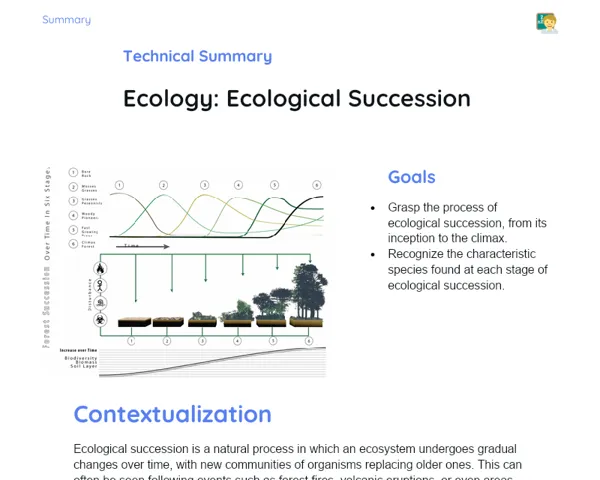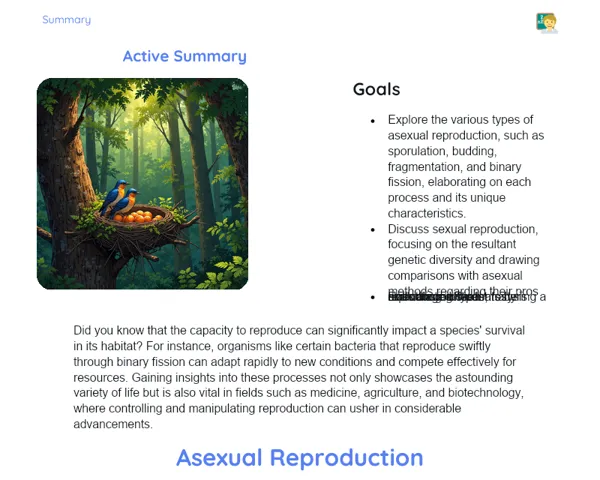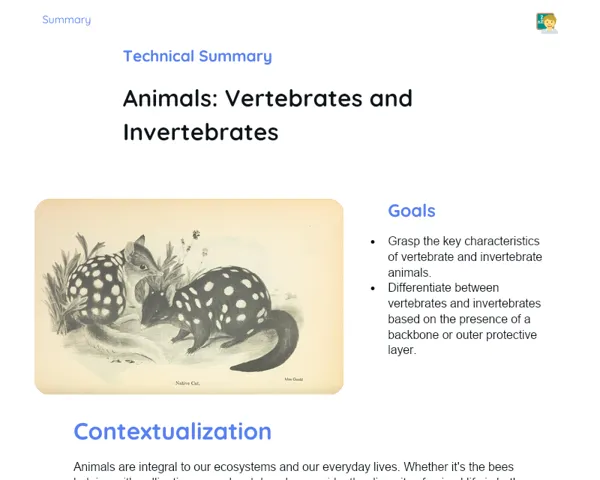Summary Tradisional | Monera Kingdom: Bacteria
Contextualization
Bacteria are single-celled microorganisms belonging to the Kingdom Monera. They are unique because they do not have a distinct nucleus and possess a cell wall that provides both shape and protection. These tiny life forms can be found in almost every nook and corner of our planet – from the depths of the oceans to extreme habitats such as arid deserts and even the chilly zones of the Himalayas. Their ability to thrive in harsh environments and reproduce rapidly makes them indispensable in nature. In our bodies, these bacteria can be both helpful and harmful; while some aid in digestion and vitamin synthesis in the gut, others are responsible for serious diseases like tuberculosis, meningitis, and cholera. A clear grasp of these characteristics and the potential dangers associated with bacteria is crucial for biology and medicine, as it paves the way for effective treatments and preventive measures.
To Remember!
Bacterial Structure
Bacteria are simple, prokaryotic, single-celled organisms that lack a well-defined nucleus, with their genetic material scattered in the cytoplasm. At the most basic level, a bacterium consists of a cell wall which provides its shape and protection, a plasma membrane that manages the entry and exit of substances, and ribosomes that are essential for protein production. Many bacteria also feature an external capsule for extra protection. Additionally, they often have flagella which act as a propeller for movement, and pili which help them adhere to surfaces and even exchange genetic material through a process called conjugation. The cell wall is mainly made up of peptidoglycan, which gives the bacteria rigidity. Differences in this cell wall, such as a thick versus thin peptidoglycan layer with an extra outer membrane, allow us to categorise them as Gram-positive and Gram-negative. These details are important when it comes to identifying bacterial infections and planning treatment strategies.
-
Prokaryotic organisms without a defined nucleus.
-
Presence of a cell wall and plasma membrane.
-
Possess flagella and pili for mobility and attachment.
Bacterial Classification
Bacteria can be classified based on various characteristics, with shape being one of the most straightforward methods. The primary shapes include cocci (spherical), bacilli (rod-shaped), and spirilla (spiral). These shapes can be observed in different arrangements, such as clusters (staphylococci) or chains (streptococci). Another widely used classification is the Gram stain test, which distinguishes bacteria into Gram-positive (retaining the violet dye) and Gram-negative (staining pink). Additionally, based on oxygen requirements, bacteria are classified as aerobic (requiring oxygen), anaerobic (growing without oxygen), facultative (capable of growing with or without oxygen), and microaerophilic (preferring low levels of oxygen).
-
Classification by shape: cocci, bacilli, and spirilla.
-
Gram stain test: Gram-positive and Gram-negative.
-
Classification by metabolism: aerobic, anaerobic, facultative, and microaerophilic.
Bacterial Reproduction
Bacteria mostly reproduce through binary fission, an asexual process where the cell duplicates its genetic material and splits into two identical daughter cells. This method is remarkably fast, especially under ideal conditions of temperature, pH, and nutrient availability, allowing bacteria to multiply swiftly. Under optimal conditions, some bacteria can divide every 20 minutes, leading to exponential growth. Alongside binary fission, some bacteria can exchange genetic material through a process known as conjugation, where one bacterium transfers part of its DNA to another using a pili bridge. This genetic exchange contributes to diversity and enables bacteria to adapt to changing environments.
-
Reproduction by binary fission.
-
Optimal conditions accelerate reproduction.
-
Conjugation allows for exchange of genetic material.
Ecological Importance of Bacteria
Bacteria play a pivotal role in sustaining ecosystems by decomposing organic matter and recycling nutrients. They are crucial in the breakdown of dead matter, returning essential nutrients to the soil and thereby supporting plant growth and overall agricultural productivity. Certain bacteria, such as those from the Rhizobium group, form beneficial partnerships with leguminous plants by converting atmospheric nitrogen into forms that plants can use, which is vital for soil fertility. Moreover, bacteria in our gut assist in digestion and vitamin synthesis, while also competing with harmful pathogens, thus playing a protective role in our health.
-
Decomposition of organic matter and nutrient cycling.
-
Nitrogen fixation in association with leguminous plants.
-
Symbiosis with organisms, including human digestion.
Pathogenic Bacteria and Diseases
While many bacteria are harmless or beneficial, some can be pathogenic, leading to serious infections. For instance, Mycobacterium tuberculosis, which causes tuberculosis, primarily affects the lungs and manifests through prolonged cough and fever. Bacterial meningitis, often due to Neisseria meningitidis, causes inflammation of the membranes around the brain and spinal cord, resulting in severe headaches and neck stiffness. Cholera, caused by Vibrio cholerae, leads to severe diarrhoea and dehydration by infecting the small intestine. Bacterial pneumonia, commonly caused by Streptococcus pneumoniae, impacts the respiratory system, triggering difficulties in breathing along with a high fever. Although antibiotics are effective in treating these infections, the rise of antibiotic resistance—due in part to their overuse—is a growing concern in modern medicine, making it increasingly challenging to manage such diseases.
-
Tuberculosis, meningitis, and cholera are serious bacterial diseases.
-
Antibiotics are used in the treatment of bacterial infections.
-
Bacterial resistance is a growing concern in medicine.
Key Terms
-
Bacteria: Unicellular prokaryotic organisms belonging to the Kingdom Monera.
-
Binary Fission: Asexual reproduction process in which one bacterial cell divides into two identical daughter cells.
-
Cocci, Bacilli, Spirilla: Basic shapes of bacteria.
-
Gram-positive and Gram-negative: Classification based on cell wall composition and reaction to the Gram stain test.
-
Aerobic, Anaerobic: Classification of bacteria based on their requirement for oxygen.
-
Flagella, Pili: Structures that facilitate bacterial movement and attachment.
-
Conjugation: The process by which bacteria exchange genetic material.
-
Nitrogen Fixation: Conversion of atmospheric nitrogen into forms usable by plants.
-
Antibiotics: Medicines that kill or inhibit the growth of bacteria.
-
Bacterial Resistance: The capacity of bacteria to resist the effects of antibiotics.
Important Conclusions
Bacteria, the single-celled organisms of the Kingdom Monera, are distinguished by their lack of a defined nucleus and a protective cell wall. They play an indispensable role in our environment by decomposing organic matter, recycling nutrients, and forming beneficial associations with plants and animals. On the flip side, some bacteria are responsible for serious diseases such as tuberculosis, meningitis, and cholera. Their classification – based on shape, Gram staining, and oxygen requirements – and their rapid reproduction through binary fission highlight both their biological significance and the challenges they pose, particularly with the increasing problem of antibiotic resistance. This understanding is vital for advancements in both biological research and public health. As educators, we encourage students to explore this fascinating subject further, thereby deepening their knowledge and contributing to scientific and healthcare advancements.
Study Tips
-
Review diagrams and images of bacterial structures to clearly understand their anatomy and classification.
-
Study real-life cases of bacterial diseases and focus on the role of antibiotics and the challenges posed by antibiotic resistance.
-
Explore scientific articles and documentaries on applications of bacteria in fields like biotechnology, bioremediation, and antibiotic production.



